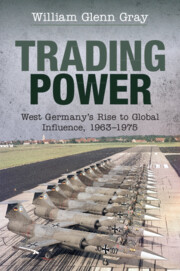Book contents
- Trading Power
- Trading Power
- Copyright page
- Contents
- Figures
- Acknowledgments
- Abbreviations
- Introduction
- 1 The Unraveling of Adenauer’s Grand Strategy (1962–1963)
- 2 America’s Junior Partner (1963–1964)
- 3 Twenty Years After (1964–1965)
- 4 The Stability Imperative (1965–1966)
- 5 Gaullist Temptations (1966–1968)
- 6 The Magnetism of Prosperity (1967–1968)
- 7 A Decisive Election (1969)
- 8 The Zenith of Ostpolitik (1970)
- 9 The European Pendulum (1970–1972)
- 10 Hazards from the Global South (1970–1972)
- 11 The Embattled Chancellor (1971–1972)
- 12 The Center of Europe (1973)
- 13 The Crisis Management Team (1973–1974)
- 14 New Structures for the West (1974–1975)
- Conclusion
- Select Bibliography
- Index
5 - Gaullist Temptations (1966–1968)
Published online by Cambridge University Press: 14 October 2022
- Trading Power
- Trading Power
- Copyright page
- Contents
- Figures
- Acknowledgments
- Abbreviations
- Introduction
- 1 The Unraveling of Adenauer’s Grand Strategy (1962–1963)
- 2 America’s Junior Partner (1963–1964)
- 3 Twenty Years After (1964–1965)
- 4 The Stability Imperative (1965–1966)
- 5 Gaullist Temptations (1966–1968)
- 6 The Magnetism of Prosperity (1967–1968)
- 7 A Decisive Election (1969)
- 8 The Zenith of Ostpolitik (1970)
- 9 The European Pendulum (1970–1972)
- 10 Hazards from the Global South (1970–1972)
- 11 The Embattled Chancellor (1971–1972)
- 12 The Center of Europe (1973)
- 13 The Crisis Management Team (1973–1974)
- 14 New Structures for the West (1974–1975)
- Conclusion
- Select Bibliography
- Index
Summary
With the forming of a Grand Coalition, headed by Kurt Kiesinger (CDU/CSU) as chancellor and Willy Brandt (SPD) as foreign minister, West Germany sought equidistance between France and the United States and pursued a new Ostpolitik in parallel with de Gaulle. As Chapter 5 explains, the project proved highly unstable; de Gaulle could do little to aid Bonn vis-à-vis Poland, and Brandt wound up preferring direct contacts with the Soviets. Disputes over Britain’s accession to the EEC further soured Franco-German relations, and Paris was hardly pleased at Bonn’s renewal of its offset promises toward London and Washington. But the U.S.–German relationship also came under strain as the United States and USSR negotiated a non-proliferation treaty (NPT) that would force West Germany to accept a permanently inferior status. Kiesinger and Brandt used their leverage with Washington to force significant changes to the NPT in the areas of nuclear research and commerce; but they also consulted with other nuclear have-nots, such as India and Iran, and contemplated Germany’s future as a middle-sized power. Increasingly, West Germans identified technology exports as a significant source of prestige.
Keywords
- Type
- Chapter
- Information
- Trading PowerWest Germany's Rise to Global Influence, 1963–1975, pp. 131 - 164Publisher: Cambridge University PressPrint publication year: 2022



